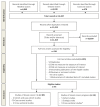Persistent Organic Pollutants and Breast Cancer: A Systematic Review and Critical Appraisal of the Literature
- PMID: 31357644
- PMCID: PMC6721417
- DOI: 10.3390/cancers11081063
Persistent Organic Pollutants and Breast Cancer: A Systematic Review and Critical Appraisal of the Literature
Abstract
Persistent organic pollutants (POPs) bioaccumulate in the food chain and have been detected in human blood and adipose tissue. Experimental studies demonstrated that POPs can cause and promote growth of breast cancer. However, inconsistent results from epidemiological studies do not support a causal relationship between POPs and breast cancer in women. To identify individual POPs that are repeatedly found to be associated with both breast cancer incidence and progression, and to demystify the observed inconsistencies between epidemiological studies, we conducted a systematic review of 95 studies retrieved from three main electronic databases. While no clear pattern of associations between blood POPs and breast cancer incidence could be drawn, POPs measured in breast adipose tissue were more clearly associated with higher breast cancer incidence. POPs were more consistently associated with worse breast cancer prognosis whether measured in blood or breast adipose tissue. In contrast, POPs measured in adipose tissue other than breast were inversely associated with both breast cancer incidence and prognosis. Differences in biological tissues used for POPs measurement and methodological biases explain the discrepancies between studies results. Some individual compounds associated with both breast cancer incidence and progression, deserve further investigation.
Keywords: breast cancer; breast cancer prognostic; breast cancer risk; persistent organic pollutants; systematic review.
Conflict of interest statement
The authors declare no conflict of interest. The funders had no role in the design of the study; in the collection, analyses, or interpretation of data; in the writing of the manuscript, or in the decision to publish the results.
Figures
Similar articles
-
Intensive weight loss and cognition: The dynamics of persistent organic pollutants in adipose tissue can explain the unexpected results from the Action for Health in Diabetes (Look AHEAD) study.Alzheimers Dement. 2020 Apr;16(4):696-703. doi: 10.1002/alz.12065. Epub 2020 Feb 24. Alzheimers Dement. 2020. PMID: 32096335
-
Partitioning of Persistent Organic Pollutants between Adipose Tissue and Serum in Human Studies.Toxics. 2022 Dec 31;11(1):41. doi: 10.3390/toxics11010041. Toxics. 2022. PMID: 36668767 Free PMC article. Review.
-
Persistent organic pollutants in adipose tissue should be considered in obesity research.Obes Rev. 2017 Feb;18(2):129-139. doi: 10.1111/obr.12481. Epub 2016 Dec 2. Obes Rev. 2017. PMID: 27911986 Review.
-
Persistent Organic Pollutants and Type 2 Diabetes: A Critical Review of Review Articles.Front Endocrinol (Lausanne). 2018 Nov 27;9:712. doi: 10.3389/fendo.2018.00712. eCollection 2018. Front Endocrinol (Lausanne). 2018. PMID: 30542326 Free PMC article. Review.
-
Associations of persistent organic pollutants in serum and adipose tissue with breast cancer prognostic markers.Sci Total Environ. 2016 Oct 1;566-567:41-49. doi: 10.1016/j.scitotenv.2016.04.188. Epub 2016 May 20. Sci Total Environ. 2016. PMID: 27213669
Cited by
-
Long Non-Coding RNA HULC Promotes the Development of Breast Cancer Through Regulating LYPD1 Expression by Sponging miR-6754-5p.Onco Targets Ther. 2019 Dec 5;12:10671-10679. doi: 10.2147/OTT.S226040. eCollection 2019. Onco Targets Ther. 2019. PMID: 31824174 Free PMC article.
-
Thyroid cancer and endocrine disruptive chemicals: a case-control study on per-fluoroalkyl substances and other persistent organic pollutants.Eur Thyroid J. 2024 May 20;13(3):e230192. doi: 10.1530/ETJ-23-0192. Print 2024 Jun 1. Eur Thyroid J. 2024. PMID: 38657654 Free PMC article.
-
Application of three statistical approaches to explore effects of dietary intake of multiple persistent organic pollutants on ER-positive breast cancer risk in the French E3N cohort.Sci Rep. 2025 Jan 15;15(1):2058. doi: 10.1038/s41598-025-85438-9. Sci Rep. 2025. PMID: 39814863 Free PMC article.
-
Distribution and risk assessment of pesticide residues in sediment samples from river Ganga, India.PLoS One. 2023 Feb 2;18(2):e0279993. doi: 10.1371/journal.pone.0279993. eCollection 2023. PLoS One. 2023. PMID: 36730256 Free PMC article.
-
MiR-27a Facilitates Breast Cancer Progression via GSK-3β.Technol Cancer Res Treat. 2020 Jan-Dec;19:1533033820965576. doi: 10.1177/1533033820965576. Technol Cancer Res Treat. 2020. PMID: 33025840 Free PMC article.
References
-
- Connell D.W., Miller G.J., Mortimer M.R., Shaw G.R., Anderson S.M. Persistent Lipophilic Contaminants and Other Chemical Residues in the Southern Hemisphere. Crit. Rev. Environ. Sci. Technol. 1999;29:47–82. doi: 10.1080/10643389991259173. - DOI
-
- Ahlborg U.G., Lipworth L., Titus-Ernstoff L., Hsieh C.-C., Hanberg A., Baron J., Trichopoulos D., Adami H.-O. Organochlorine Compounds in Relation to Breast Cancer, Endometrial Cancer, and Endometriosis: An Assessment of the Biological and Epidemiological Evidence. Crit. Rev. Toxicol. 1995;25:463–531. doi: 10.3109/10408449509017924. - DOI - PubMed
Publication types
LinkOut - more resources
Full Text Sources


